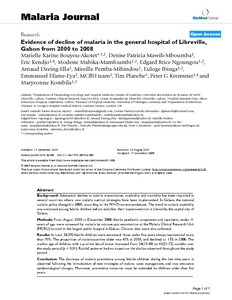Bouyou-Akotet, MK;
Mawili-Mboumba, DP;
Kendjo, E;
Mabika-Mamfoumbi, M;
Ngoungou, EB;
Dzeing-Ella, A;
Pemba-Mihindou, M;
Ibinga, E;
Efame-Eya, E;
MCRU team, ;
et al.
Bouyou-Akotet, MK; Mawili-Mboumba, DP; Kendjo, E; Mabika-Mamfoumbi, M; Ngoungou, EB; Dzeing-Ella, A; Pemba-Mihindou, M; Ibinga, E; Efame-Eya, E; MCRU team; Planche, T; Kremsner, PG; Kombila, M
(2009)
Evidence of decline of malaria in the general hospital of Libreville, Gabon from 2000 to 2008.
MALARIA JOURNAL, 8 (300).
ISSN 1475-2875
https://doi.org/10.1186/1475-2875-8-300
SGUL Authors: Planche, Timothy David
![[img]](https://openaccess.sgul.ac.uk/1057/1.hassmallThumbnailVersion/1475-2875-8-300.pdf)  Preview |
|
["document_typename_application/pdf; charset=binary" not defined]
Published Version
Download (308kB)
| Preview
|
Abstract
BACKGROUND: Substantial decline in malaria transmission, morbidity and mortality has been reported in several countries where new malaria control strategies have been implemented. In Gabon, the national malaria policy changed in 2003, according to the WHO recommendations. The trend in malaria morbidity was evaluated among febrile children before and after their implementation in Libreville, the capital city of Gabon.
METHODS: From August 2000 to December 2008, febrile paediatric outpatients and inpatients, under 11 years of age, were screened for malaria by microscopic examination at the Malaria Clinical Research Unit (MCRU) located in the largest public hospital in Gabon. Climatic data were also collected.
RESULTS: In total, 28,092 febrile children were examined; those under five years always represented more than 70%. The proportion of malaria-positive slides was 45% in 2000, and declined to 15% in 2008. The median age of children with a positive blood smear increased from 24(15-48) to 41(21-72) months over the study period (p < 0.01). Rainfall patterns had no impact on the decline observed throughout the study period.
CONCLUSION: The decrease of malaria prevalence among febrile children during the last nine years is observed following the introduction of new strategies of malaria cases management, and may announce epidemiological changes. Moreover, preventive measures must be extended to children older than five years.
| Item Type: |
Article
|
| Additional Information: |
© 2009 Bouyou-Akotet et al; licensee BioMed Central Ltd.
This is an Open Access article distributed under the terms of the Creative Commons Attribution License (http://creativecommons.org/licenses/by/2.0), which permits unrestricted use, distribution, and reproduction in any medium, provided the original work is properly cited. |
| Keywords: |
Age Factors, Animals, Blood, Child, Child, Preschool, Climate, Female, Gabon, Hospitals, General, Humans, Infant, Malaria, Male, Microscopy, Plasmodium, Prevalence, Science & Technology, Life Sciences & Biomedicine, Parasitology, Tropical Medicine, PLASMODIUM-FALCIPARUM, TRANSMISSION INTENSITY, PEDIATRIC MALARIA, CHILDREN, CHLOROQUINE, IMPLEMENTATION, EPIDEMIOLOGY, RESISTANCE, PREGNANCY, MORBIDITY |
| SGUL Research Institute / Research Centre: |
Academic Structure > Infection and Immunity Research Institute (INII) |
| Journal or Publication Title: |
MALARIA JOURNAL |
| ISSN: |
1475-2875 |
| Related URLs: |
|
| Dates: |
| Date | Event |
|---|
| 17 December 2009 | Published |
|
| Web of Science ID: |
WOS:000273762300001 |
  |
Download EPMC Full text (PDF)
|
 |
Download EPMC Full text (HTML)
|
| URI: |
https://openaccess.sgul.ac.uk/id/eprint/1057 |
| Publisher's version: |
https://doi.org/10.1186/1475-2875-8-300 |
Statistics
Item downloaded times since 30 Apr 2012.
Actions (login required)
 |
Edit Item |



